Crabbing is one of Puget Sound’s most popular recreational fisheries. Each year, sport fishers catch more than 1.5 million pounds of Dungeness crab, using pots, ring nets, and – in the case of wade and dive fishers – their bare hands.
The Puget Sound crab management area includes Washington marine areas 5 through 13 (including the Strait of Juan de Fuca, San Juan Islands, Puget Sound, and Hood Canal) and marine area 4 (Neah Bay) east of the Bonilla-Tatoosh line. View the WDFW crab regulations webpage for details.
Download the Puget Sound crabbing pamphlet (PDF)
All recreational crabbers 15 years or older must carry a current Washington fishing license. Options range from an annual shellfish/seaweed license to combination fishing licenses, valid for a single day or up to a year. Catch record cards are not required along the coast.
Here's what else you need to know before you go crabbing in Puget Sound:
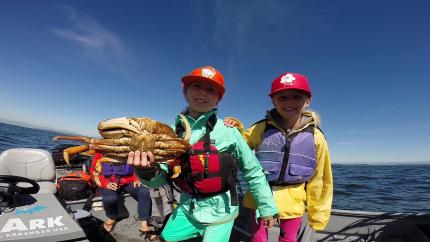
- In addition to the proper license, all crabbers in Puget Sound waters are required to carry a Dungeness crab Catch Record Card (CRC). All Dungeness crab kept must be recorded on your CRC immediately in ink.
- Know the difference between male and female crabs. Only male Dungeness crab can be kept.
- Know how to measure the male crabs.
- Know how to identify softshell crabs, learn more on this webpage.
- Know how to record your Dungeness crab on a CRC. For instructions on recording refer to “Recording Your Dungeness Catch” below. For instructions on reporting your CRC refer to “Reporting Your Catch to WDFW” below.
- Know the types of crabs and how to identify them. Different rules apply to Dungeness crab and Red Rock crab.
- Make sure your traps and gear meet all the requirements in the regulation pamphlet.
Help protect our crab resources
Report illegal activity with as much detail as possible as soon as it occurs. Call 1-877-933-9847 or submit a report to WDFW Police at: wdfw.wa.gov/about/enforcement/report
Methods of harvesting
Crabs can be harvested in a variety of ways:
- Wading with a dip net or dip rake.
- With devices cast from a fishing pole.
- By hand using scuba gear.
- With pots that catch and hold crab.
- With ringnets and star traps that allow crab to enter and exit freely.
Any method which involves piercing the crab shell, poisons, or chemical irritants is illegal.
Piers are often crowded and offer limited opportunity for Dungeness crab. However some good information on marine piers can be found on the public fishing piers page.
Using a boat will allow access to many of the most productive crab waters in Puget Sound, and is the preferred way to reach crab harvest grounds. It is illegal for boaters to pull gear which has a buoy with someone else’s name on it. Setting or retrieving gear from a boat is illegal from one hour after sunset to one hour before sunrise.
Preparing traps, buoys, and lines
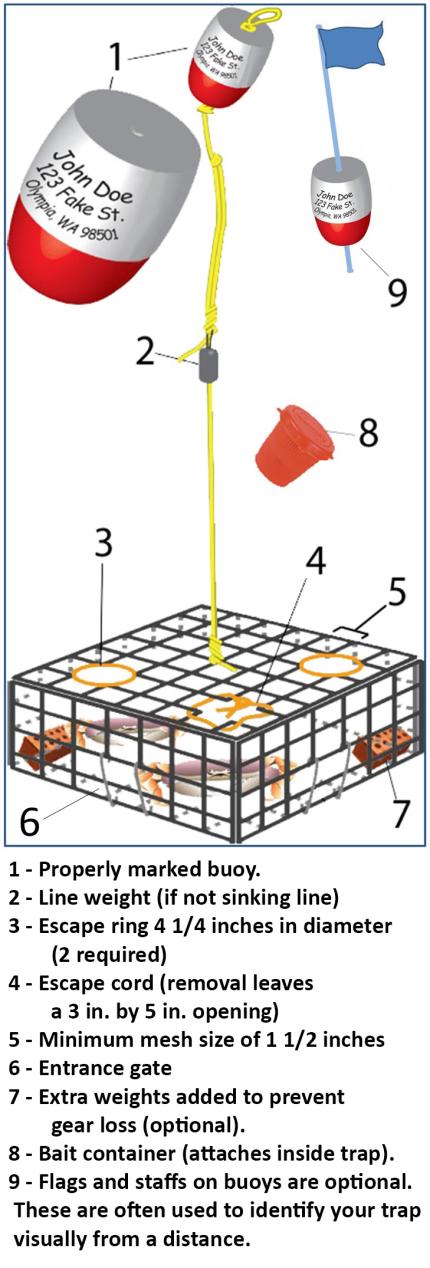
Recreational crab traps and ringnets come in a variety of designs. The sport fishing rules pamphlet details the requirements of crab pots which include:
- A minimum mesh size of 1 1/2 inch.
- Two escape rings 4 1/4 inch diameter in upper half of pot so small crabs can escape.
- A volume less than 13 cubic feet.
- A biodegradable device utilizing 100% natural fiber cord that will degrade over time. This allows captured crabs to escape if your trap is lost.
Check your traps to be sure there are no large holes in the mesh, that tunnel entrance gates swing freely, and escape cord has not already deteriorated.
Each person may fish two units of gear. Each unattended pot or ringnet must be attached by a line to it’s own buoy. Each line must be durable and either sink in salt water (preferred) or be weighted that it does not float on the surface. Floating lines are often entangled in propellers and result in lost traps, unnecessary crab mortality, and propeller damage.
The buoy should be visible on the surface at all times except during extreme tidal conditions. It must also be half red and half white in color. Buoys must be legibly marked with the fisher’s full name and current address. A phone number is optional, but recommended.
Baiting and deploying traps
Traps and ringnets can be baited with an assortment of baits. The best baits include fish carcasses, clams, and squid. Baits that are commonly used and widely available include chicken and turkey. Use bait containers that allow some access to the bait and allow water to flow around it to carry off scent. Try to place baits in the trap so that crab must enter to feed.
Be smart and prevent the loss of your traps and the corresponding waste of crabs. Lost traps will continue to “ghost fish” because captured crabs die and will act as bait for new victims.
- Do not set traps in areas with extreme currents or heavy boat and/or barge traffic.
- Add five to ten pounds of weight to lighter traps so they are not swept off by currents.
- Use lines of correct length and know your water depth. Allow for the tide height variation and extra scope.
- Use proper sinking lines and buoys. Use extra buoys in extreme currents.
- Whenever possible, mark your traps with GPS so they can be easily found.
Capturing, measuring, and sorting
Crabs must be sorted and all undersized males, softshell crabs, and female Dungeness crabs must be released immediately back to the water. It is also illegal to keep only the claws of crabs.
Female crabs can be identified by their wider abdominal flap.
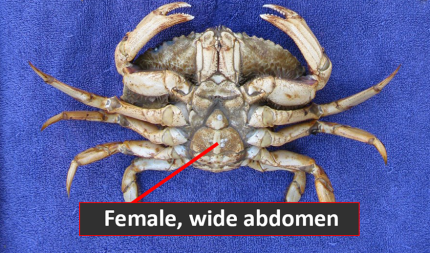
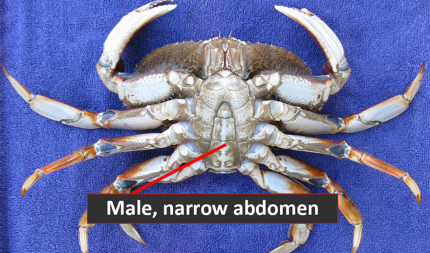
To measure male crabs, use a crab caliper available from most sporting goods vendors.
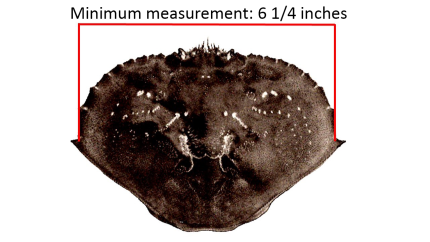
Measure the distance inside the points as shown. Do not measure to the tips of the points. The minimum size for male Dungeness crabs in Puget Sound is 6 1/4 inches.
Estimating or using rulers and/or dollar bills is unwise, could result in possession of undersize crab, and a fine.
When releasing crab, take care to gently place them back to the water. If crabbing from a pier, this may require lowering them down with a bucket and line.
Recording your Dungeness catch
Puget Sound crabbers need to record all Dungeness crab kept on their catch record card (CRC).
Immediately after retaining a Puget Sound Dungeness crab, it must be recorded on your CRC in ink. This must be done before you put the trap back in the water. Record the Marine Area, month, and day in the first columns. Check off each Dungeness crab as it is kept. Do not record Red Rock crab or any other species of crab on a CRC. When done for the day, tally all the checkmarks and record the total Dungeness crab kept.
Transporting, cleaning, and cooking
Keep crabs cool and moist until they are cooked. Use seawater soaked towels with ice on top. Do not submerge your catch in seawater, as crabs will quickly deplete oxygen and die unless the water is aerated.
Crabs may be cleaned before or after cooking. For the cleanest and safest product, the Washington State Department of Health (DOH) advises to kill and clean your crab before cooking.
If you decide to clean crabs in the field, you must keep the shell to prove the crab was legal to harvest. Kill the crab with a sharp blow to the middle of its underside with a cleaver or similar object. Pull the top of the shell off from the back towards the front. Break the crab into two parts down the midline. Remove the viscera, mouthparts, tail and gills. Rinse the body if desired.
Boil crabs in salt water (3 to 5 ounces of salt per gallon). Cook for a total of 10-15 minutes with at least 3 of those minutes being after the water returns to a rolling boil. After cooking, immerse them into cold water for about 2 minutes to stop the cooking process and loosen the meat from the shell.
Reporting your catch to WDFW
Crabbers must report their Dungeness crab catch by the date printed on the Catch Record Card. It is required to report your Catch Record Card even if you did not harvest any crab or attempt to go crabbing. If you fail to do so, an administrative penalty will be applied toward your next purchase of a crab endorsement. You can report your catch by:
- dropping off the CRC at any WDFW regional office;
- mailing the CRC to the address shown on the card;
- or reporting online at https://fishhunt.dfw.wa.gov/login